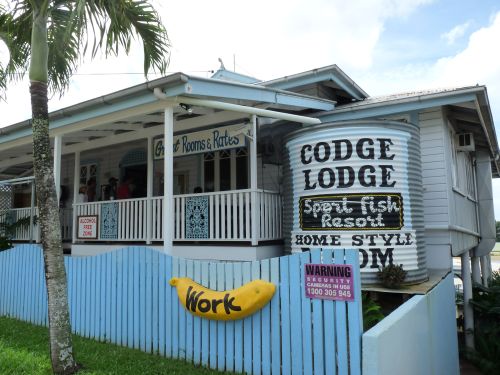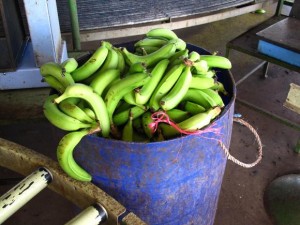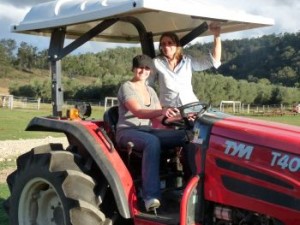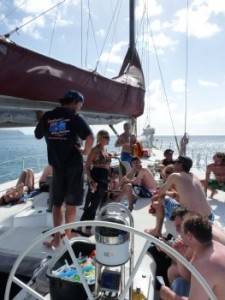Working Holidays in Australia
 Maybe you just finished college. Maybe you were recently laid off. Or you are having a quarter life crisis and are in search of adventure. Or perhaps you want to brush up on your Aussie slang and learn how to drink with the best of them. Whatever your reason, if you are wondering where you can go to travel, explore and work along the way to help fund your adventures, you should probably consider heading to Australia. Not only will you be able to enjoy the added benefit of being able to speak English, but Australia is also the perfect place to enjoy longer-term travel. With a great backpacker infrastructure (great hostels, lots of camper vans to rent, buses and more), traveling up and down the East Coast of Australia is both beautiful and easy. Plus, with Australia recently opening up their Working Holiday Visa program to Americans, now may just be the perfect time to pack your bags and live it up Down Under for awhile.
Maybe you just finished college. Maybe you were recently laid off. Or you are having a quarter life crisis and are in search of adventure. Or perhaps you want to brush up on your Aussie slang and learn how to drink with the best of them. Whatever your reason, if you are wondering where you can go to travel, explore and work along the way to help fund your adventures, you should probably consider heading to Australia. Not only will you be able to enjoy the added benefit of being able to speak English, but Australia is also the perfect place to enjoy longer-term travel. With a great backpacker infrastructure (great hostels, lots of camper vans to rent, buses and more), traveling up and down the East Coast of Australia is both beautiful and easy. Plus, with Australia recently opening up their Working Holiday Visa program to Americans, now may just be the perfect time to pack your bags and live it up Down Under for awhile.
>>Looking for more information? Check out my article on Working Holiday Visas in Australia and How it All Works
Getting a Visa
 When I hear the word “visa,” bureaucratic nightmares and loads of paperwork are the first things that pop into my mind. However, getting a Working Holiday Visa (WHV) in Australia is really not difficult at all. Much unlike my experience when I applied for a French student visa and had to appear with piles of paperwork and stacks of documents at the consulate, the WHV application is all online, takes less than an hour and does not require waiting in any lines or wading through pages of fine print.
When I hear the word “visa,” bureaucratic nightmares and loads of paperwork are the first things that pop into my mind. However, getting a Working Holiday Visa (WHV) in Australia is really not difficult at all. Much unlike my experience when I applied for a French student visa and had to appear with piles of paperwork and stacks of documents at the consulate, the WHV application is all online, takes less than an hour and does not require waiting in any lines or wading through pages of fine print.
In fact, I spoke with several working holidayers during my recent trip to Queensland, Australia whole told me they were approved for the visa in less than 24 hours. The application costs $230 AUD (about $210 USD as of May 5, 2010).
Who is the visa for?
(From the Australia Department of Immigration web site):
The Work and Holiday visa is for tertiary educated* people aged 18 to 30 who want to travel and work for up to 12 months in Australia. This visa allows you to supplement the cost of your holiday through periods of temporary or casual employment. Most countries under this visa program have a limit on the number of Work and Holiday visas issued per year.
>>Read my article on Working Holiday Visas in Australia and How it All Works
Types of Jobs and Pay
The WHV does not require that the visa holder have any specific kind of job. That being said, there are definitely jobs that are much easier for working holidayers to get. Since most of those traveling with a WHV intend to get temporary employment for just a few months to help fund adventures in Australia, most do not look for professional office type jobs in their fields.
The easiest jobs for working holidayers to get are usually in hospitality (bars, restaurants etc.), tourism (like cooking on a sail boat), fruit picking or other agricultural work. While certainly not glamorous jobs, many will be surprised at how well-paying they are. Because Australia has a much higher minimum wage than in the U.S., even jobs like fruit picking pay $17/hr.
Jobs on cattle stations can also pay quite well. If you already have valuable skills (like being able to operate large tractors) you could earn up to $1,500/week, though most jobs pay between $250-$800 AUD per week. Plus, since many of the jobs on cattle stations include room and board and are located in remote areas in the Outback, you are guaranteed to take almost all of that money home.
Fruit Picking
 When I first heard that fruit picking was a popular job among working holidayers, I recoiled a bit. I immediately imagined long, grueling days with little pay. However, after visiting a banana farm outside of Cairns in Queensland, Australia where many working holidayers are employed, I began to realize maybe spending a few months fruit picking wouldn’t be all that bad. While the work is certainly physical and tough, the pay is good (as I said before, about $17/hour) and a few months of hard labor could help fund the rest of your travels in Australia.
When I first heard that fruit picking was a popular job among working holidayers, I recoiled a bit. I immediately imagined long, grueling days with little pay. However, after visiting a banana farm outside of Cairns in Queensland, Australia where many working holidayers are employed, I began to realize maybe spending a few months fruit picking wouldn’t be all that bad. While the work is certainly physical and tough, the pay is good (as I said before, about $17/hour) and a few months of hard labor could help fund the rest of your travels in Australia.
There are many working hostels scattered across Australia. At these hostels you’ll get simple, but cheap accommodations and a guaranteed job. I visited the Codge Lodge working hostel during my trip and was impressed not only to find nice, spacious rooms, but also a bar/restaurant, big wrap around porch, swimming pool, and ample opportunities for work. The Codge Lodge gives working holidayers opportunities to work at the nearby banana farm.
For visa holders from many countries (Belgium, Canada, Republic of Cyprus, Denmark, Estonia, Finland, France, Germany, Hong Kong, Republic of Ireland, Italy, Japan, Republic of Korea, Malta, Netherlands, Norway, Sweden, Taiwan and United Kingdom) fruit picking for 3 months can also give you a 1-year extension on your visa for those who want to stay posted up Down Under for a bit longer.
>>Find a working hostel in Australia or read more about the Codge Lodge
Agricultural Work
 If you’d rather spend your time cattle wrangling and tractor driving than picking bananas during your time in Australia, there is also plenty of agricultural work to be found on the country’s many cattle stations. With vast tracks of land, big cattle stations and a small population, there are always farms and ranches looking for workers.
If you’d rather spend your time cattle wrangling and tractor driving than picking bananas during your time in Australia, there is also plenty of agricultural work to be found on the country’s many cattle stations. With vast tracks of land, big cattle stations and a small population, there are always farms and ranches looking for workers.
If you are like me and lack all skills necessary to work on a cattle station or farm—that is you can’t ride a horse, muster sheep on motorbike, build fences or drive tractors—it doesn’t mean you still couldn’t get a job working doing some or all of these things. Luckily, there are programs that can not only help train you up in farm work, but also help you land a job when you are done with your training.
VisitOz has a 5-day farm work crash course for those who want to learn the skills they’ll need to land a job on farms and cattle stations around Australia. Located about 250 km from Brisbane, the Springbrook farm outside of the tiny bush town of Goomeri (pop. 400) is the training center for VisitOz participants hoping to land a job. The farm, which is owned by a Scots couple named Dan and Joanna Burnet, raises beef cattle along with teaching backpackers and working holidayers basic farm skills.
The training course for VisitOz at Springbrook farm teaches:
- Motorbiking (they use motorbikes on farms and cattle stations to wrangle livestock)
- Chainsaw operation
- Cattle work
- Horseback riding and cattle mustering (another word for wrangling)
- Fencing (barbed wire mostly)
- Tractor driving and farm equipment operation
The work is certainly hard physical labor in most cases, but if you’ve dreamed of being able to work mustering cattle on an outback farm, this is certainly a good option. The program is not free. Enrolling in the training program costs $1,990 AUD (a little over $1,500 USD), but that costs not only includes your 5-day training, but includes a guaranteed job placement (if you successfully complete training), help with travel arrangements, 9 total days of accommodation (5 days on the farm, a night in Brisbane and a 3 nights on a jet-lag recovery trip to Rainbow Beach off the coast), and your meals while staying on the farm.
There is also something to be said about having a plan and a almost guaranteed job waiting for you when you arrive in Australia. The peace of mind and learning how to motorbike (my favorite part of the day I spent on Springbrook) is probably well worth the price.
Jobs pay between $250-$1500 per week and almost always include room and board. Plus, since many of these jobs are located in remote areas in the Outback, you’ll take away almost all of that money, meaning just a few month of work could fund travels for the rest of the year.
>>Find out more about the VisitOz program
Hospitality/Tourism and other Jobs
 In addition to helping place workers on cattle stations and farms doing agricultural work, VisitOz can also help place workers in hospitality type jobs. Other jobs you can get through VisitOz include:
In addition to helping place workers on cattle stations and farms doing agricultural work, VisitOz can also help place workers in hospitality type jobs. Other jobs you can get through VisitOz include:
- Working at an Outback pub (they like the ladies for these jobs. No explanation need as to why)
- Distance Education and Tutoring—since many of these cattle stations are far away from any town or city, children are educated at home.
- House help—you can also often get a job helping out with domestic chores like babysitting, cooking, cleaning etc.
 If you choose to set out and get a job on your own, you can also find jobs in bars/restaurants around Australia. While you may have to work a bit harder to get a job placement and it may take a little longer, with perseverance, you can definitely score a job doing something other than fruit picking and agricultural work.
If you choose to set out and get a job on your own, you can also find jobs in bars/restaurants around Australia. While you may have to work a bit harder to get a job placement and it may take a little longer, with perseverance, you can definitely score a job doing something other than fruit picking and agricultural work.
If you are an ocean lover or sailor (or wish you were), you can also get a job working on some kind of chartered boat. When I went Sailing in the Whitsunday Islands, I met working holidayers who had scored jobs as cooks and assistants on the boats that tour the islands.
More Info
- If you would like to read more about all of the stipulations, rules and regulations or want to apply for a Working Holiday Visa, visit the Australia Department of Immigration web site
- Find out more about VisitOz and how they can help you land a job Down Under
- There is a blog dedicated to Working Holidays in Australia that can help you with everything from what to pack to where you’ll have the best chance landing a job.
- Mike Barish over at Gadling (whom I traveled with in Queensland, Australia) has also written some informative posts about Working Holidays in Australia. Read his account of Work and Play in Australia: Farm Work and Work and Play in Australia: Fruit Picking